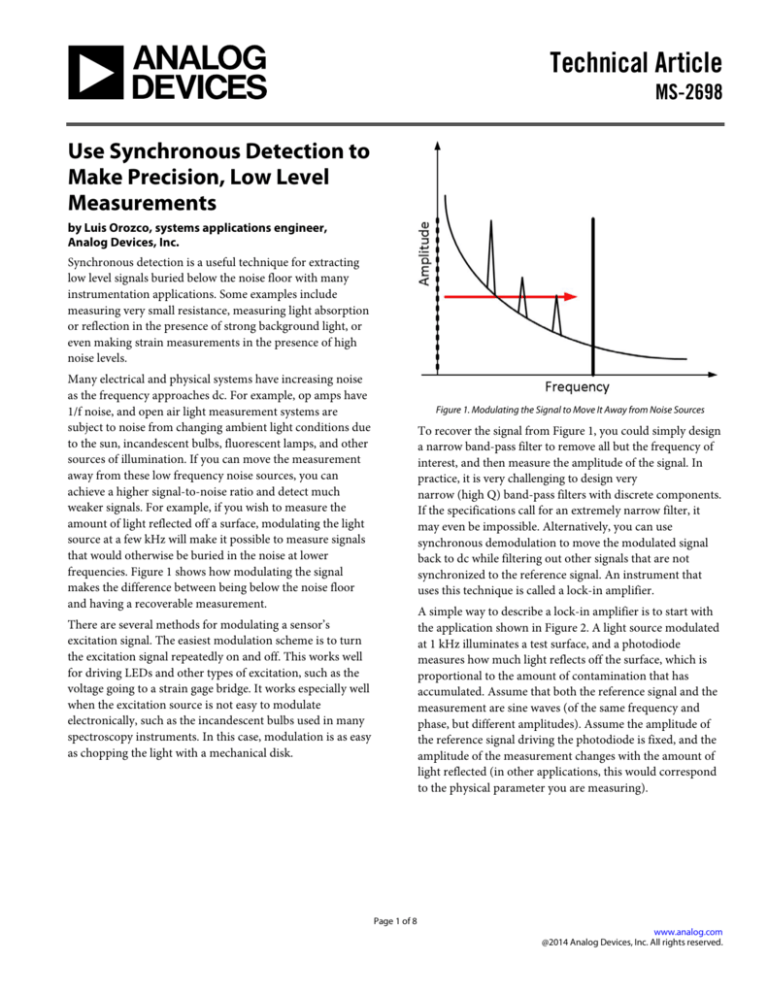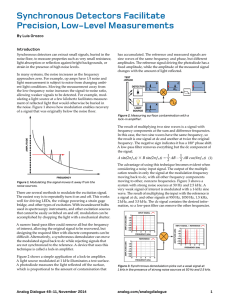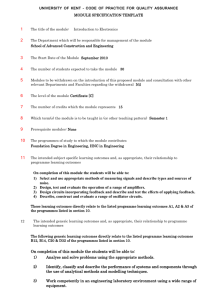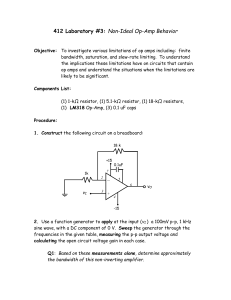
Technical Article
MS-2698
Use Synchronous Detection to
Make Precision, Low Level
Measurements
by Luis Orozco, systems applications engineer,
Analog Devices, Inc.
Synchronous detection is a useful technique for extracting
low level signals buried below the noise floor with many
instrumentation applications. Some examples include
measuring very small resistance, measuring light absorption
or reflection in the presence of strong background light, or
even making strain measurements in the presence of high
noise levels.
Many electrical and physical systems have increasing noise
as the frequency approaches dc. For example, op amps have
1/f noise, and open air light measurement systems are
subject to noise from changing ambient light conditions due
to the sun, incandescent bulbs, fluorescent lamps, and other
sources of illumination. If you can move the measurement
away from these low frequency noise sources, you can
achieve a higher signal-to-noise ratio and detect much
weaker signals. For example, if you wish to measure the
amount of light reflected off a surface, modulating the light
source at a few kHz will make it possible to measure signals
that would otherwise be buried in the noise at lower
frequencies. Figure 1 shows how modulating the signal
makes the difference between being below the noise floor
and having a recoverable measurement.
Figure 1. Modulating the Signal to Move It Away from Noise Sources
To recover the signal from Figure 1, you could simply design
a narrow band-pass filter to remove all but the frequency of
interest, and then measure the amplitude of the signal. In
practice, it is very challenging to design very
narrow (high Q) band-pass filters with discrete components.
If the specifications call for an extremely narrow filter, it
may even be impossible. Alternatively, you can use
synchronous demodulation to move the modulated signal
back to dc while filtering out other signals that are not
synchronized to the reference signal. An instrument that
uses this technique is called a lock-in amplifier.
A simple way to describe a lock-in amplifier is to start with
the application shown in Figure 2. A light source modulated
at 1 kHz illuminates a test surface, and a photodiode
measures how much light reflects off the surface, which is
proportional to the amount of contamination that has
accumulated. Assume that both the reference signal and the
measurement are sine waves (of the same frequency and
phase, but different amplitudes). Assume the amplitude of
the reference signal driving the photodiode is fixed, and the
amplitude of the measurement changes with the amount of
light reflected (in other applications, this would correspond
to the physical parameter you are measuring).
There are several methods for modulating a sensor’s
excitation signal. The easiest modulation scheme is to turn
the excitation signal repeatedly on and off. This works well
for driving LEDs and other types of excitation, such as the
voltage going to a strain gage bridge. It works especially well
when the excitation source is not easy to modulate
electronically, such as the incandescent bulbs used in many
spectroscopy instruments. In this case, modulation is as easy
as chopping the light with a mechanical disk.
Page 1 of 8
www.analog.com
@2014 Analog Devices, Inc. All rights reserved.
Technical Article
MS-2698
The result of multiplying two sine waves together is a signal
with frequency components at the sum and difference of the
two input sine waves. In this case, the two sine waves have the
same frequency, and Equation 1 shows how the result is one
signal at dc and another at twice the original frequency (the
negative sign indicates it has 180° of phase shift). A low-pass
filter removes everything but the dc component of the signal.
consider a noisy input signal. The output of the
multiplication stage will still result in only the signal at the
modulation frequency moving back to dc, with all other
frequency components moving to other, non-dc
frequencies. For example, Figure 3 depicts a system with
strong noise sources at 50 Hz and 2.5 kHz, and a very weak
signal of interest modulated with a sine wave at 1 kHz.
The advantage of using this technique is more evident if you
𝐴𝑠𝑖𝑛(2𝜋𝑓𝑚 𝑡) × 𝐵 𝑠𝑖𝑛(2𝜋𝑓𝑚 𝑡) =
=
1
2
1
1
1
𝐴𝐵 × 𝑐𝑜𝑠(2𝜋 × (𝑓𝑚 − 𝑓𝑚 ) × 𝑡) − 𝐴𝐵 × 𝑐𝑜𝑠(2𝜋 × (𝑓𝑚 + 𝑓𝑚 ) × 𝑡)
2
2
1
𝐴𝐵 − 𝐴𝐵𝑐𝑜𝑠(2𝜋2𝑓𝑚 𝑡)
2
(Equation 1)
The result of multiplying the input with the reference is a
signal at dc, and other signals at 950 Hz, 1.05 kHz, 1.5 kHz,
2 kHz, and 3.5 kHz. The dc signal contains the desired
information, so you can use a low-pass filter to remove all of
the other frequencies.
Figure 2. Measuring Surface Contamination with a Lock-In Amplifier
Figure 3. Synchronous Demodulation Picks Out a Weak, 1 kHz Signal in the Presence of Strong Noise Sources at 50 Hz and 2.5
kHz Page 2 of 8
Technical Article
MS-2698
Using a square wave-based lock-in amplifier requires a
simple circuit, but its noise rejection performance is inferior
to a system using sine waves. Figure 5 shows the frequency
domain representation of using a square wave as the sensor
excitation and reference signal. A square wave is made up of
an infinite sum of sine waves at the fundamental and all odd
harmonics. Multiplying two square waves of the same
frequency involves multiplying each sine component of the
reference times each sine component of the measured signal.
The result is a dc signal that contains energy from every
harmonic of the square wave. Any unwanted signals that
appear at any odd harmonic frequency will not be filtered
out (although it will be scaled down depending on which
harmonic it falls in). When designing a square wave-based
lock-in amplifier, it is important to pick a modulation
frequency with harmonics that are not at any frequency or
harmonics of known noise sources. For example, instead of
picking a 1 kHz modulation frequency (the 20th harmonic of
50 Hz), pick 1.0375 kHz, which does not coincide with
harmonics of 50 Hz or 60 Hz.
Any noise components that are close to the signal of interest
will appear at frequencies close to dc, so it is important to
pick a modulation frequency that does not have strong noise
sources near it. If this is not possible, then you will need a
low-pass filter with a very low cutoff frequency and sharp
response, at the expense of a long settling time.
PRACTICAL LOCK-IN IMPLEMENTATIONS
Generating a sine wave to modulate the signal source can be
impractical, and some systems use a square wave instead.
Generating a square wave excitation is much simpler than
generating a sine wave, because it can be done with
something as simple as a microcontroller pin that toggles an
analog switch or a MOSFET.
The circuit of Figure 4 is an easy way to implement a
hardware-based lock-in amplifier. A microcontroller or
other digital device generates a square wave excitation signal
that causes the sensor to respond. In the case of a
photodiode, the first amplifier would be a current-to-voltage
converter, while a strain gage bridge would require an
instrumentation amplifier.
Even with this drawback, the circuit is simple and low cost.
Using a low noise amplifier and picking the right
modulation frequency can still result in a great
improvement over trying to make a dc measurement.
The same signal that excites the sensor controls the ADG619
SPDT switch. When the excitation signal is positive, the
ADG619 configures the amplifier for a gain of +1. When the
excitation is negative, the ADG619 configures the amplifier
for a gain of –1, which essentially “flips” the negative side of
the square wave. This is mathematically equivalent to
multiplying the measured signal times the reference square
wave. The output RC filter removes any signals at other
frequencies, and the output voltage is a dc signal equal to
half the peak-to-peak voltage of the measured square wave.
Figure 5. If the Input Signal (A) and the Reference (B) Are Both Square Waves,
Multiplying Them Together (C) Effectively Demodulates Every Harmonic of
the Input Signal
A SIMPLE, INTEGRATED ALTERNATIVE
The circuit of Figure 4 requires an op amp, analog switch,
and some discrete components, plus a reference clock from
a microcontroller. An alternative to this circuit is to use an
integrated synchronous demodulator like the ADA2200.
Figure 6 shows the internal blocks of the ADA2200, which
include a buffered input, a programmable IIR filter, and a
multiplier. It also includes a block that shifts the reference
signal by 90°, which makes it easy to measure or compensate
for phase shifts between the reference clock and input signal.
Figure 4. Lock-In Amplifier Using Square Wave Excitation
Although the circuit is simple, it is important to pick the
right op amp for the job. The input ac coupling stage
removes most of the input noise at low frequencies, but any
1/f noise and offset error from the last amplifier are not
filtered out. The ADA4077-1 has 250 nV p-p of noise from
0.1 Hz to 10 Hz and 0.55 µV/ °C of offset drift, making it an
ideal candidate for this application.
Page 3 of 8
Technical Article
MS-2698
The benefits of this operation are explained in detail in the
following section.
Figure 8. Using a Sine Wave as the Reference Signal Prevents Noise from
Demodulating to DC
Figure 6. ADA2200 Internal Architecture
One additional difficulty is that if there is any phase shift
between the reference signal and the measured signal, the
result of multiplying the two together will result in a lower
amplitude output than if they were perfectly in phase. This
can occur if the sensor signal conditioning circuit includes
any filters (which introduce phase delay). With an analog
lock-in amplifier, the only way to address this is to include
additional phase compensation circuits in the reference
signal path. This is not trivial, because the circuit needs to be
adjustable to compensate for different phase delays, and will
vary with temperature, component tolerance, etc. An easier
alternative is to add a second multiplication stage that
multiplies the measured signal with a 90° phase shifted
version of the reference. The result of this second stage will
be a signal proportional to the out of phase component of
the input. Figure 9 shows this concept.
Implementing a lock-in detection circuit with the ADA2200
simply requires applying a clock frequency that is 64 times
the desired reference frequency. The default configuration
of the programmable filter is for a band-pass response,
removing the need to ac couple the signal as in the circuit of
Figure 4. The ADA2200’s sampled analog output will
generate images around multiples of the sampling rate. You
can use an RC filter followed by a Σ-Δ ADC to remove these
images and measure only the demodulated dc component of
the signal.
The outputs of the low-pass filters after the two multiplier
stages are low frequency signals proportional to the in-phase
(I) and quadrature (Q) components of the input. To
calculate the magnitude of the input signal, simply take the
sum of the squares of the I and Q outputs. An additional
benefit of this architecture is that you can also calculate the
phase between the excitation/reference signal and the input.
Figure 7. Lock-In Amplifier Implementation with the ADA2200
IMPROVING THE SQUARE WAVE LOCK-IN CIRCUIT
Figure 8 shows an improvement to a square wave modulated
circuit. If you excite the sensor with a square wave, but now
multiply the measured signal with a sine wave of the same
frequency and phase, only the signal content at the
fundamental frequency will move to dc, while all of the
other harmonics will move to non-dc frequencies. This
makes it easy to use a low-pass filter and eliminate
everything but the dc component of the measured signal.
Page 4 of 8
Technical Article
MS-2698
a sine wave of the same frequency and phase as the input
reference. One caveat of this approach is that the internally
generated sine wave must have low distortion.
Although this system could be implemented using a discrete
PLL and multipliers, using an FPGA to implement the lockin amplifier functions results in several performance benefits.
Figure 11 shows a lock-in amplifier built with an FPGA using
a front end based on the ADA4528-1 zero-drift amplifier and
an AD7175 24-bit Σ-Δ ADC. An application like this does
not need very high bandwidth, so we can set the lock-in
amplifier’s equivalent noise bandwidth to 50 Hz. The device
under test is again any sensor that can be excited externally.
The ADA4528-1 is configured with a noise gain of 20 to take
advantage of the full scale range of the ADC
Figure 9. Using a Quadrature Version of the Reference Signal to Calculate
Magnitude and Phase
All of the systems discussed so far generate a reference
signal that excites a sensor. One final refinement to the lock-
Figure 10. Using a PLL to Lock on to an External Reference Signal
in amplifier is to allow an external signal to act as a
reference. For example, Figure 10 shows a system that uses a
broadband incandescent light to test the optical properties
of a surface. A system like this can measure parameters such
as the reflectivity of mirrors, or the amount of
contamination on a surface. It is much simpler to use a
mechanical chopper disk to modulate an incandescent
source than to apply electronic modulation. A cheap
position sensor close to the chopper disk generates a square
wave reference signal to feed the lock-in amplifier. Rather
than using this signal directly, a phase-locked loop generates
(arbitrarily set for this example). Although dc errors do not
affect the measurement, it is still important to minimize
offset drift and 1/f noise because they will decrease the
available dynamic range, especially when the amplifier is
configured for high gain. The ADA4528-1’s 2.5 µV of worst
case input offset error represents only 10 ppm of the
AD7175’s full scale input range (with a 2.5 V reference). The
digital high-pass filter after the ADC removes any dc offset
and very low frequency noise. To calculate the output noise,
we need to know the voltage noise density of the AD7175.
The data sheet specifies the ADC noise at 5.9 µV rms with an
Page 5 of 8
Technical Article
MS-2698
other unwanted signals present at the harmonic frequencies,
just like when two square waves are multiplied together (see
Figure 5). One advantage of generating this reference sine
wave digitally is that it is relatively easy to generate a very
low distortion signal simply by adjusting the number
precision. For example, Figure 12 shows four digitally
generated sine waves using 4-, 8-, 16-, and 32-bit precision.
Obviously, using 4-bit precision results in performance not
much different from the case in Figure 5, but the situation
quickly improves by using higher precision numbers. At
16 bits of precision, it would take some effort to generate an
analog signal with such low total harmonic distortion
(THD), and at 32 bits, where the THD is over –200 dB, it
would be impossible to match with an analog circuit. In
addition, because these are digitally generated signals, they
are perfectly repeatable. Once the data has been converted to
the digital domain and enters the FPGA, there is no
additional noise or drift to take into account.
output data rate of 50 kSPS, using the Sinc5 + Sinc1 filter
and with the input buffer enabled. The equivalent noise
bandwidth with these settings is 21.7 kHz, which results in a
voltage noise density of 40 nV/√Hz. The broadband input
noise of the ADA4528 is 5.9 nV/√Hz, which appears at the
output as 118 nV/√Hz resulting in a combined noise density
of 125 nV/√Hz. Since the digital filter has an equivalent noise
bandwidth of only 50 Hz, the output noise is 881 nVrms.
With a ±2.5 V input range, this results in a system with
126 dB of dynamic range. We can trade off bandwidth for
dynamic range by adjusting the frequency response of the
low-pass filter. For example, setting the filters for an
equivalent noise bandwidth of 1 Hz results in 143 dB of
dynamic range, and setting the bandwidth to 250 Hz results
in 119 dB of dynamic range.
After the multipliers, the low-pass filters remove any high
frequency components and output the in-phase and
quadrature components of the signal. Continuing with the
assumption that the equivalent noise bandwidth of the
filters is only 50 Hz, there is no reason to deliver data at the
original sampling rate of 250 kSPS. The low-pass filters can
include a decimation stage to reduce the output data rate.
The last step in the process is to calculate the magnitude and
phase of the input signal from the in-phase and quadrature
components.
Figure 11. FPGA-Based Lock-In Amplifier
The digital phase-locked loop generates a sine wave locked
to the excitation signal (which can be an external signal, or
internally generated in the FPGA, and does not have to be a
sine wave). Any harmonics in the reference sine wave will
also multiply with the input signal, demodulating noise and
Page 6 of 8
Technical Article
MS-2698
Figure 12. Numerically Generated Sine Waves with Different Number Precision
attractive when compared with a simple dc measurement.
An improvement from this circuit is to use a sine wave
reference and a multiplier, but this can be challenging to
implement in the analog domain. For the ultimate
performance, consider using a low noise, high resolution
Σ-Δ ADC, such as the AD7175, to digitize the input signal,
and then generate the reference sine wave, and all of the
other elements of the lock-in amplifier in the digital domain.
SUMMARY
Small, low frequency signals buried in the noise floor can be
difficult to measure, but applying modulation and lock-in
amplifier techniques can result in high precision
measurements. In its simplest form, a lock-in amplifier can
be an op amp that switches between two gains. Although
this does not result in the lowest noise performance, the
simplicity and low cost of the circuit still make it very
Page 7 of 8
Technical Article
MS-2698
AUTHOR
Luis Orozco [luis.orozco@analog.com] is a system
applications engineer in ADI’s industrial and
instrumentation segment. He focuses on precision
instrumentation, chemical analysis, and environmental
monitoring applications. Luis joined ADI in February 2011.
Prior to joining ADI, he designed data acquisition
equipment for over 10 years.
RESOURCES
Share this article on
One Technology Way • P.O. Box 9106 • Norwood, MA 02062-9106, U.S.A.
Tel: 781.329.4700 • Fax: 781.461.3113 • www.analog.com
Trademarks and registered trademarks are the property of their
respective owners.
TA12671-0-9/14
www.analog.com
©2014 Analog Devices, Inc. All rights reserved.
Page 8 of 8









